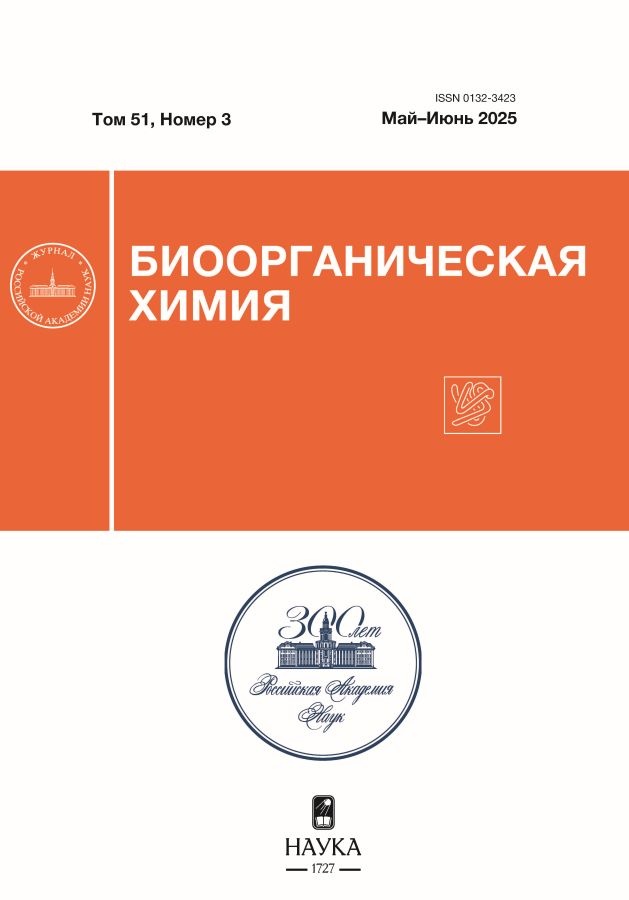Sequence specificity of dimeric bisbenzimidazoles to AT-sequences of DNA of different nucleotide composition determined by footprinting
- Autores: Naberezhnov D.S.1,2, Arutuynyan A.F.1, Beniaminov A.D.1, Smirnov N.M.1, Kaluzhny D.N.1, Zhuze A.L.1, Susova O.Y.1,2
-
Afiliações:
- Engelhardt Institute of Molecular Biology, Russian Academy of Sciences
- N.N. Blokhin National Medical Research Center of Oncology of the Ministry of Health
- Edição: Volume 51, Nº 3 (2025)
- Páginas: 408-417
- Seção: ОБЗОРНАЯ СТАТЬЯ
- URL: https://rjonco.com/0132-3423/article/view/686910
- DOI: https://doi.org/10.31857/S0132342325030048
- EDN: https://elibrary.ru/KQCIMC
- ID: 686910
Citar
Texto integral
Resumo
The study aimed to investigate the site-specificity of binding to DNA of three series of minor groove ligands – dimeric bisbenzimidazoles DB2(n), DB2P(n), and DB2Py(n) – using DNAase I footprinting. The compounds consist of two bisbenzimidazole units linked by oligomethylene linkers of varying lengths (n), with structural modifications to enhance DNA-binding properties. The binding specificity of the compounds was determined using DNAase I footprinting. The DB2(n) and DB2P(n) series are analogs of Hoechst 33342, modified by removing hydrophobic ethoxyphenol cores and introducing hydrophilic aminomethylene groups. The DB2Py(n) series incorporates a pyrrolcarboxamide group, a structural unit of the AT-specific antibiotic netropsin. The interaction of these compounds with DNA sequences was analyzed to identify their binding preferences. All studied compounds demonstrated specificity for AT-rich DNA sequences. The DB2P(n) and DB2(n) series exhibited increased affinity for (AATT)3 and TTTT sequences. The DB2Py(n) series showed high specificity to AT-rich regions, with a preference for the TTTT motif. None of the compounds interacted with sequences containing fewer than four AT base pairs. These findings highlight the influence of structural modifications on DNA-binding specificity and affinity. The study revealed that dimeric bisbenzimidazoles DB2(n), DB2P(n), and DB2Py(n) exhibit distinct binding preferences for AT-rich DNA sequences, with DB2Py(n) showing a pronounced affinity for the TTTT motif. The results demonstrate the potential of these compounds as tools for targeting specific DNA sequences, with implications for molecular biology and drug design.
Texto integral
Sobre autores
D. Naberezhnov
Engelhardt Institute of Molecular Biology, Russian Academy of Sciences; N.N. Blokhin National Medical Research Center of Oncology of the Ministry of Health
Email: susovaolga@gmail.com
Rússia, ul. Vavilova 32, Moscow, 119991; Kashirskoe shosse 24, Moscow, 115522
A. Arutuynyan
Engelhardt Institute of Molecular Biology, Russian Academy of Sciences
Email: susovaolga@gmail.com
Rússia, ul. Vavilova 32, Moscow, 119991
A. Beniaminov
Engelhardt Institute of Molecular Biology, Russian Academy of Sciences
Email: susovaolga@gmail.com
Rússia, ul. Vavilova 32, Moscow, 119991
N. Smirnov
Engelhardt Institute of Molecular Biology, Russian Academy of Sciences
Email: susovaolga@gmail.com
Rússia, ul. Vavilova 32, Moscow, 119991
D. Kaluzhny
Engelhardt Institute of Molecular Biology, Russian Academy of Sciences
Email: susovaolga@gmail.com
Rússia, ul. Vavilova 32, Moscow, 119991
A. Zhuze
Engelhardt Institute of Molecular Biology, Russian Academy of Sciences
Email: susovaolga@gmail.com
Rússia, ul. Vavilova 32, Moscow, 119991
O. Susova
Engelhardt Institute of Molecular Biology, Russian Academy of Sciences; N.N. Blokhin National Medical Research Center of Oncology of the Ministry of Health
Autor responsável pela correspondência
Email: susovaolga@gmail.com
Rússia, ul. Vavilova 32, Moscow, 119991; Kashirskoe shosse 24, Moscow, 115522
Bibliografia
- Wu K., Peng X., Chen M., Li Y., Tang G., Peng J., Peng Y., Cao X. // Chem. Biol. Drug. Des. 2022. V. 99. P. 736–757. https://doi.org/10.1111/cbdd.14022
- Tyagi Y.K., Jali G., Singh R. // Med. Chem. 2022. V. 22. P. 3280–3290. https://doi.org/10.2174/1871520622666220429134818
- Alniss H.Y., Al-Jubeh H.M., Msallam Y.A., Siddiqui R., Makhlouf Z., Ravi A., Hamdy R., Soliman S.S.M., Khan N.A. // Eur. J. Med. Chem. 2024. V. 271. P. 116440. https://doi.org/10.1016/j.ejmech.2024.116440
- Pan T., He X., Chen B., Chen H., Geng G., Luo H., Zhang H., Bai C. // Eur. J. Med. Chem. 2015. V. 5. P. 500–513. https://doi.org/10.1016/j.ejmech.2015.03.050
- Phan N.K., Huynh T.K., Nguyen H.P., Le Q.T., Nguyen T.C., Ngo K.K., Nguyen T.H., Ton K.A., Thai K.M., Hoang T.K. // ACS Omega. 2023. V. 28. P. 28733–28748. https://doi.org/10.1021/acsomega.3c03530
- Teng M.K., Usman N., Frederick C.A., Wang A.H. // Nucleic Acids Res. 1988. V. 25. P. 2671–2690. https://doi.org/10.1093/nar/16.6.2671
- Breusegem S.Y., Clegg R.M., Loontiens F.G. // J. Mol. Biol. 2002. V. 1. P. 1049–1061. https://doi.org/10.1006/jmbi.2001.5301
- Bazhulina N.P., Nikitin A.M., Rodin S.A., Surovaya A.N., Kravatsky Y.V., Pismensky V.F., Archipova V.S., Martin R., Gursky G.V. // J. Biomol. Struct. Dyn. 2009. V. 26. P. 701–718. https://doi.org/10.1080/07391102.2009.10507283
- Streltsov S.A., Gromyko A.V., Oleinikov V.A., Zhuze A.L. // J. Biomol. Struct. Dyn. 2006. V. 24. P. 285–302. https://doi.org/10.1080/07391102.2006.10507121
- Ivanov A.A., Salianov V.I., Strel’tsov S.A., Cherepanova N.A., Gromova E.S., Zhuze A.L. // Russ. J. Bioorg. Chem. 2011. V. 37. P. 530–541. https://doi.org/10.1134/s1068162011040054
- Ivanov A.A., Koval V.S., Susova O.Y., Salyanov V.I., Oleinikov V.A., Stomakhin A.A., Shalginskikh N.A., Kvasha M.A., Kirsanova O.V., Gromova E.S., Zhuze A.L. // Bioorg. Med. Chem. Lett. 2015. V. 1. P. 2634–2638. https://doi.org/10.1016/j.bmcl.2015.04.087
- Neidle S. // Nat. Prod. Rep. 2001. V. 18. P. 291–309. https://doi.org/10.1039/a705982e
- Susova O.Y., Karshieva S.S., Kostyukov A.A., Moiseeva N.I., Zaytseva E.A., Kalabina K.V., Zusinaite E., Gildemann K., Smirnov N.M., Arutyunyan A.F., Zhuze A.L. // Act. Nat. 2024. V. 16. P. 86–100. https://doi.org/10.32607/actanaturae.27327
- Naberezhnov D.S., Kirsanov K.I., Glazunov V.Y., Belitskiy G.A., Yakubovskaya M.G. // Russ. Fundam. Res. 2015. V. 2. P. 5599–5604.
- Caneva R., De Simoni A., Mayol L., Rossetti L., Savino M. // Biochim. Biophys. Acta. 1997. V. 7. P. 93–97. https://doi.org/10.1016/s0167-4781(97)00091-2
- Isagulieva A.K., Kaluzhny D.N., Beniaminov A.D., Soshnikova N.V., Shtil A.A. // Int. J. Mol. Sci. 2022. V. 23. P. 8871. https://doi.org/10.3390/ijms23168871
Arquivos suplementares

















